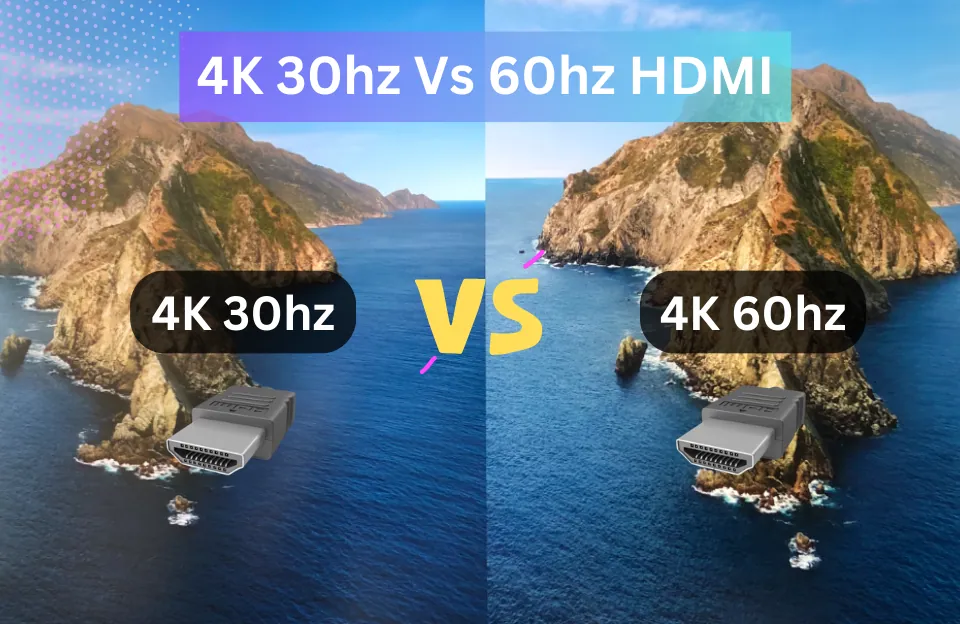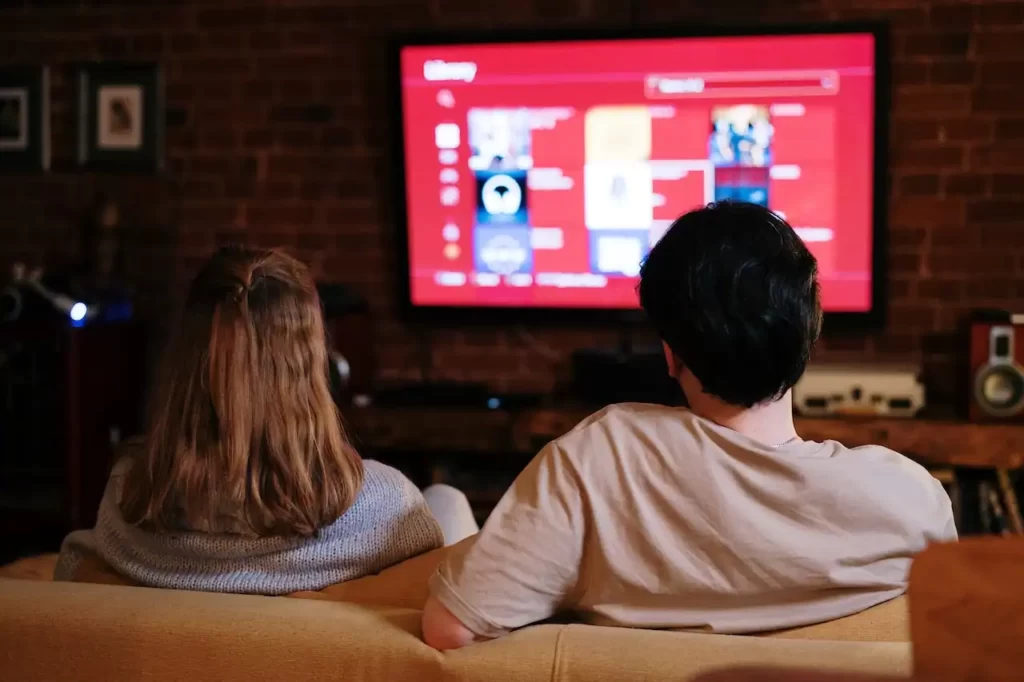The HDMI (High-Definition Multimedia Interface) connection now become popular as a standard medium for connecting various devices together. This connection is most versatile because it can transfer high-definition data within the connected devices. You can connect devices like Projectors, TVs, Monitors, and all other HDMI-enabled devices.
As gradually Technology evolves, newer versions of HDMI have been introduced to support higher resolutions and refresh rates. One common question that arises when choosing an HDMI cable is whether to go for 4K 30hz vs 60hz.
So if you are also here with the above query, we are here to share the differences between these two options and help to pick one according to your specific requirements and preferences. Therefore, by the end, you’ll have a clear understanding of which HDMI cable with a specific refresh rate suits your needs best.
What are Refresh Rates? (30Hz and 60Hz)
Before discussing the specifics of 4K HDMI, it’s essential to grasp the concept of refresh rate. When we talk about the refresh rate, it refers to the number of times an image on a screen is refreshed or redrawn per second.
It is typically measured in hertz (Hz). A higher refresh rate results in smoother motion and reduces motion blur, which is crucial for fast-paced content like sports or action movies.
Understanding HDMI
HDMI, short for High-Definition Multimedia Interface, is a digital interface used to transmit uncompressed audio and video signals between devices. It allows for the seamless transmission of high-quality content and supports various resolutions and refresh rates.
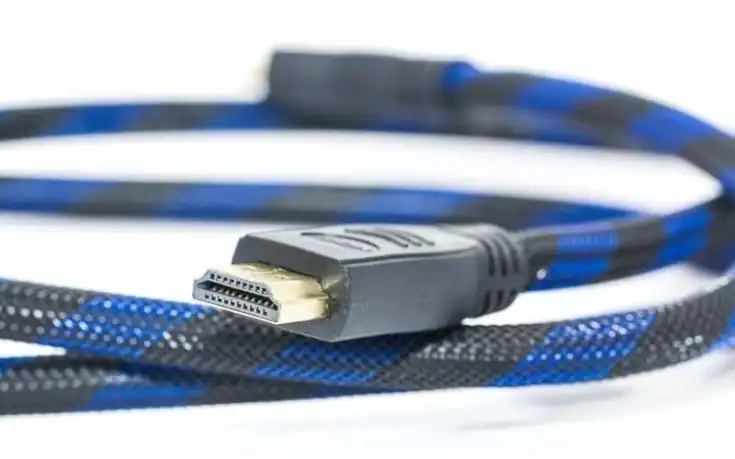
HDMI Versions (HDMI Cable 30hz vs 60hz)
When choosing between 4K 30Hz and 60Hz, it’s essential to consider the HDMI standard your device supports:
- HDMI 1.4: Supports 4K resolution but only at 30Hz. This means if your device only has an HDMI 1.4 port, you’re limited to 30Hz at 4K.
- HDMI 2.0: Supports 4K resolution at 60Hz. If your device has an HDMI 2.0 port, you can enjoy the benefits of a 60Hz refresh rate.
- HDMI 2.1: Supports even higher refresh rates and resolutions, but for the scope of this article, HDMI 2.0 is the standard to focus on for 4K 60Hz.
What is 4K?
To comprehend the significance of refresh rate in the context of HDMI, let’s first understand what 4K resolution entails.
The term 4K’s simple meaning is that a device that can process or support around 4000 pixels.
In terms of resolution 4K resolution also known as Ultra HD (UHD) offers four times the number of pixels compared to Full HD or 1920×1080 resolution. It contains 3840×2160 pixels, and with this much amount of pixels, it delivers stunning visual clarity, sharpness, and detail.
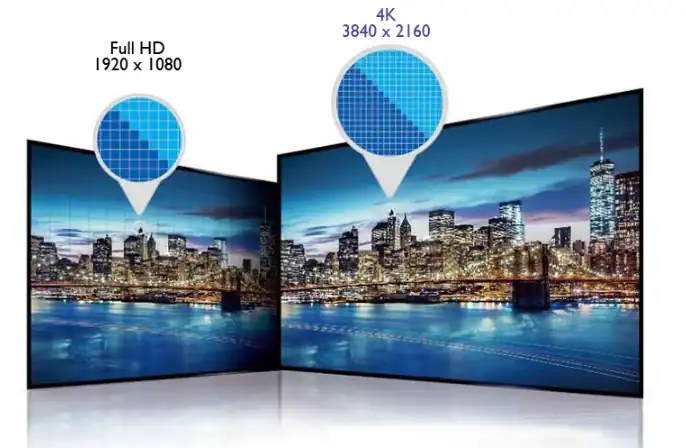
Benefits of 4K
The adoption of 4K resolution has significantly improved the visual experience across various devices. Whether you’re watching movies, playing video games, or editing multimedia content, the benefits of 4K are evident.
The increased pixel count provides more precise details, realistic textures, and improved depth perception, resulting in a more immersive and lifelike experience.
The Role of HDMI in 4K
Importance of HDMI in Transmitting 4K Signals
As we discussed earlier, HDMI is the most widely used interface for transmitting high-definition audio and video signals between devices, it also ensures that 4K content is delivered without compression, preserving the quality of the original source.
Types of HDMI Cables Supporting 4K
Not all HDMI cables are created equal. For 4K content, HDMI 2.0 or later cables are recommended, as they support higher bandwidth necessary for 4K signals.
Recommended:
- Projector Ports: What Are The Ports Available In A Projector?
- Learn All About Projector Specs
- What is a 4K Projector?
- How Do 3D Projectors Work?
- 4:3 vs 16:9 Projector Screen
- 1600×900 vs 1920×1080 – What You Need to Know
What is 30Hz?
30Hz refers to the refresh rate of the display. It indicates the number of times per second the image on the screen refreshes.
At 30Hz, the screen updates 30 times in a second, which is considered the minimum standard for smooth video playback.
This is typically sufficient for non-demanding tasks like basic office work or browsing the internet.
4K 30Hz HDMI
In terms of HDMI cable, 4K 30Hz HDMI cable supports a refresh rate of 30 frames per second. It is the standard refresh rate for most 4K devices and offers decent image quality for casual users.
However, for fast-paced action scenes or gaming, the 30Hz refresh rate may result in noticeable motion blur or screen tearing, affecting the overall visual experience.
Common Use Cases
4K 30Hz HDMI is ideal for standard TV viewing, casual gaming, and streaming content that doesn’t require ultra-smooth motion.
It’s also sufficient for presentations and general computer use where high frame rates are not critical.
Recommended 4K 30Hz HDMI Cables
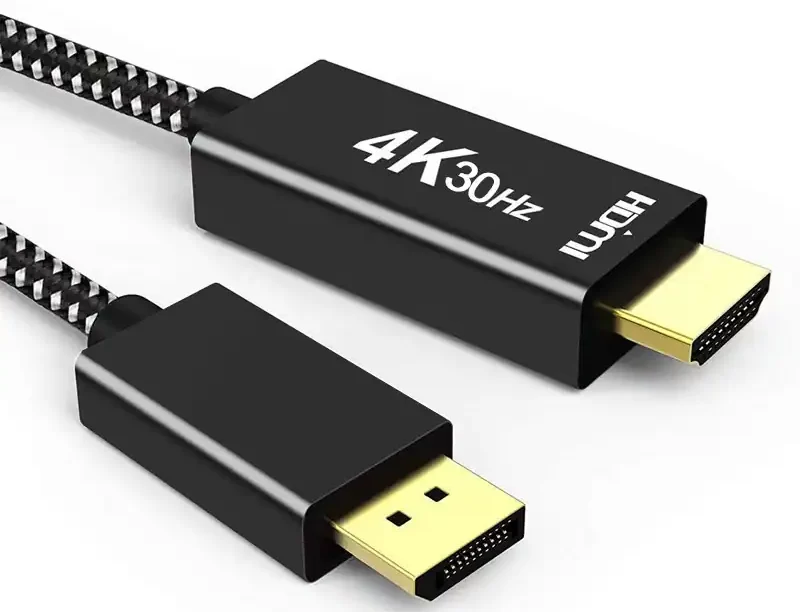
Advantages of 4K 30Hz HDMI
Despite its limitations, 4K 30Hz HDMI has its advantages. It requires less bandwidth compared to higher refresh rates, making it suitable for streaming content or connecting devices with limited capabilities.
Additionally, it is more widely supported across various devices, ensuring compatibility with older equipment or less advanced display technologies.
What is 60Hz?
60Hz, on the other hand, represents a higher refresh rate. With 60Hz, the display refreshes 60 times per second, resulting in even smoother motion and more fluid visuals.
This higher refresh rate is preferable for gaming, video playback, and any activity that benefits from smoother motion.
4K 60Hz HDMI
As we’ve discussed above, a 4K 60Hz HDMI cable, supports a refresh rate of 60 frames per second. This higher refresh rate results in a smoother, more fluid motion and is particularly beneficial for gaming enthusiasts or those who enjoy fast-action movies.
The increased frame rate reduces motion blur, enhancing the clarity and realism of the displayed content.
Common Use Cases
4K 60Hz HDMI shines in high-end gaming, fast-paced movie watching, and professional video editing. The enhanced smoothness ensures a more immersive and responsive experience.
Recommended 4K 60Hz HDMI Cables
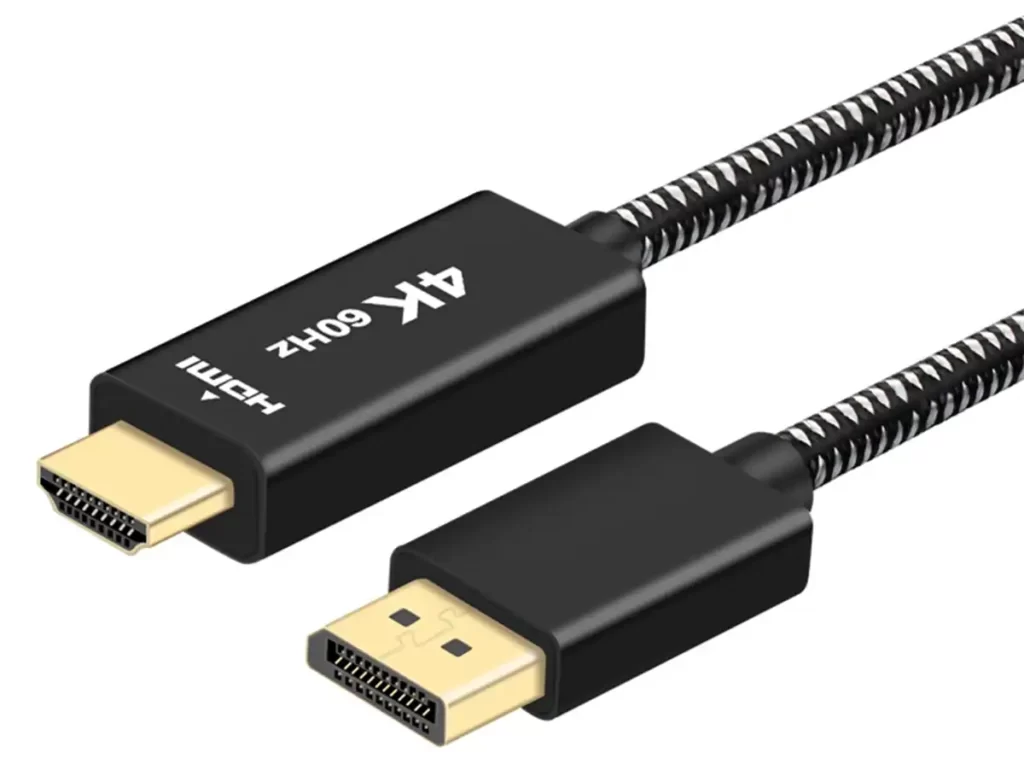
Advantages of 4K 60Hz HDMI
The primary advantage of 4K 60Hz HDMI lies in its ability to deliver a more immersive visual experience. The higher refresh rate ensures smoother transitions and reduces latency, making it ideal for competitive gaming or applications that demand real-time responsiveness.
It is worth noting that to take full advantage of 4K 60Hz HDMI, both the source device and the display need to support this refresh rate.
4K 30hz Vs 60hz HDMI
The primary difference between 30Hz and 60Hz lies in the smoothness of motion. While both options can provide a decent viewing experience, 60Hz offers a significant advantage in terms of fluidity and responsiveness.
The higher refresh rate reduces motion blur and makes fast-moving objects appear sharper and more natural.
4K 30hz Vs 60hz HDMI: Comparison Table
| Features | 4K 30Hz | 4K 60Hz |
| Resolution | 4K (3840×2160) | 4K (3840×2160) |
| Refresh Rate | 30Hz | 60Hz |
| Frame Rate | 24fps | 60fps |
| Image Quality | Provides Good Picture Quality | Provides Excellent Picture Quality |
| Smoothness | Smooth | Very smooth |
| Ideal For | TV, Movies. Computer Monitors | Gaming, Live Streaming |
| Lag | Some lag | A bit Lag |
| Cost | Usually Less expensive | Usually More Expensive |
The technical difference is straightforward: 60Hz can display twice as many frames as 30Hz in the same time period, leading to smoother motion and less noticeable screen tearing or lag.
4K 30hz vs 60hz: As you can see in the table, both 4K 30Hz and 60Hz options offer a 4K resolution of 3840×2160 pixels. This is a critical factor because it defines the level of detail and clarity in the displayed content. Users seeking high-quality visuals will appreciate this feature.
A higher refresh rate typically results in smoother motion, making it vital for certain applications like gaming and video playback. Talking about Frame rate, it is measured in frames per second (fps) and is closely related to the refresh rate.
HDMI Cable 30hz vs 60hz: 4K at 30Hz offers 24fps, which is standard for movies, while 4K at 60Hz provides a smoother 60fps.
Smoothness, as mentioned in the table, is a subjective but important aspect. 4K at 60Hz is described as “very smooth,” which is especially beneficial for fast-paced activities like gaming. It contributes to a more immersive and enjoyable user experience.
Lag, or input delay, is a concern for gamers. The table indicates that both options have some degree of lag, with 4K at 60Hz having “a bit lag.” Gamers and competitive users may want to consider this aspect when deciding between the two.
4K 30Hz vs. 4K 60Hz: Performance Comparison
With a higher refresh rate, such as 60Hz, you’ll experience smoother motion, especially during fast-paced scenes or gaming. On the other hand, 4K 30Hz might result in a slight stutter or choppiness in certain scenarios, but it can still provide a good viewing experience for most non-action-intensive content.
For gamers, the difference between 4K 30Hz and 60Hz can be more pronounced. Higher refresh rates not only offer smoother visuals but also reduce input lag, making gameplay more responsive. If gaming is a priority for you, opting for 4K 60Hz can significantly enhance your gaming sessions, especially with games that support higher frame rates.
In terms of visual clarity and detail, both 4K 30Hz and 4K 60Hz offer the same resolution. The difference lies in how smooth the motion appears on the screen. While 4K 60Hz provides a more fluid experience, 4K 30Hz can still deliver sharp and detailed visuals, especially for static images and slower-moving content.
Impact of Refresh Rates on HDMI Performance
How refresh rates affect HDMI signal transmission
The refresh rate impacts the bandwidth required for the HDMI signal. Higher refresh rates demand more data to be transmitted, which can be a limiting factor for older HDMI versions or lower-quality cables.
Differences in HDMI performance at 30Hz vs. 60Hz
At 30Hz, the data load is lighter, meaning it’s less taxing on the cable and port. However, the visual performance is noticeably less smooth compared to 60Hz, which provides a better experience for fast-moving content.
Choosing the Right HDMI for Your Setup
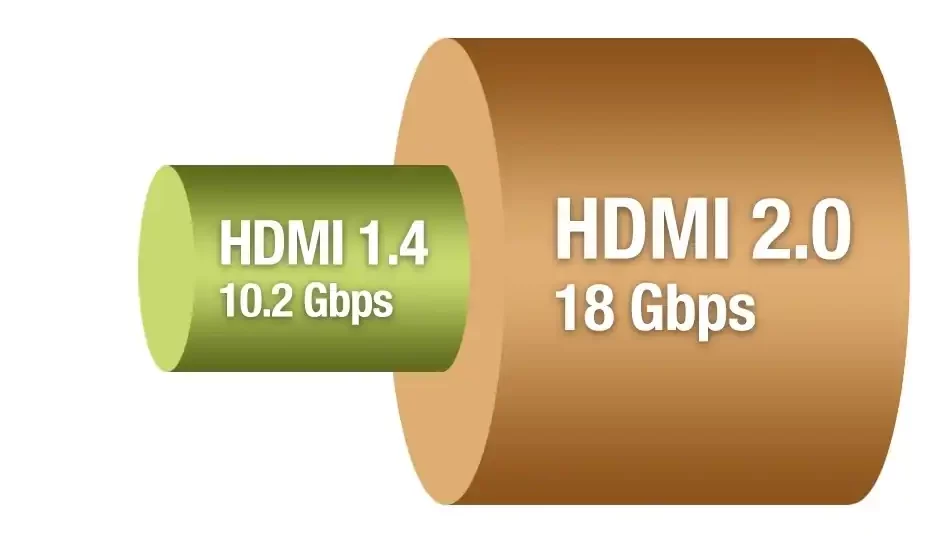
To ensure you choose the right HDMI for your setup, start by identifying the capabilities of your display. Check the manufacturer’s specifications or user manual to determine if it supports 4K at 60Hz. If it does, investing in an HDMI 2.0 or HDMI 2.1 cable is recommended to fully leverage the capabilities of your display and source devices.
However, if your display is limited to 4K 30Hz, there’s no need to invest in an HDMI 2.0 cable. HDMI 1.4 cables are more affordable and readily available, making them a suitable choice for setups that don’t require higher refresh rates.
So, ensure that HDMI cables are backward compatible, meaning an HDMI 2.0 cable can work with a 4K 30Hz device, but it won’t provide any additional benefits.
Additionally, consider future-proofing your setup. If you plan to upgrade your display or source devices in the near future, investing in an HDMI 2.0/2.1 cable might be a wise decision to ensure compatibility with newer devices that support 4K at 60Hz.

Major Considerations
When deciding between 4K 30Hz vs 60Hz HDMI, several factors come into play. Let’s explore them to make a more informed choice.
Gaming and Multimedia
If you’re an avid gamer or enjoy watching action-packed movies, a 60Hz HDMI connection is highly recommended.
The higher refresh rate ensures smoother gameplay and enhances your overall viewing experience.
It minimizes input lag and allows for more precise control, making it ideal for competitive gaming.
Display and Content Support
Another crucial consideration is the compatibility of your display and the content you intend to watch or play. While 4K at 30Hz is more widely supported, it might not be sufficient for certain applications.
If your display supports 60Hz, opting for a 60Hz HDMI connection will unleash the full potential of your device and provide you with a superior visual experience.
HDMI Cable Considerations
To achieve 60Hz at 4K resolution, it’s essential to use an HDMI cable that supports the required bandwidth. Not all HDMI cables are created equal, and older cables may not be capable of transmitting high-resolution content at higher refresh rates.
Ensure that you have a High-Speed HDMI cable or an HDMI 2.1 cable to harness the benefits of 60Hz.
User Experience and Comfort
How refresh rates affect eye strain and fatigue
Higher refresh rates like 60Hz can reduce eye strain and fatigue, providing a more comfortable viewing experience over long periods.
Long-term use implications
For long-term use, especially for intensive tasks, 60Hz or higher is recommended to ensure a comfortable and efficient working environment.
Cost Considerations
Price can also be a factor in your decision:
- 4K 30Hz Displays: Generally more affordable and suitable for users who don’t require high refresh rates.
- 4K 60Hz Displays: Often come at a premium, but the investment is worthwhile for those seeking better performance and future readiness.
See More:
- Best 4K Projector for Gaming
- Best Projector For Projection Mapping
- smART Sketcher Projector
- Best Long Throw Projectors In Full HD And 4K
- Best Cheap Projector For PowerPoint Presentations
- PG 13 vs TV 14: What You Need to Know!
4K 30hz Vs 60hz: FAQs

Is 4K resolution only available with a 60Hz refresh rate?
No, 4K resolution can be achieved with both 30Hz and 60Hz refresh rates. The choice of refresh rate depends on the specific requirements of your content and setup.
Can I use a 30Hz HDMI cable with a 60Hz source?
While it’s technically possible, it is recommended to use an HDMI cable that matches the refresh rate of your source device for optimal performance and compatibility.
How does refresh rate impact video playback quality?
Refresh rate affects motion smoothness and reduces motion blur. Higher refresh rates, such as 60Hz, resulting in smoother and more fluid video playback, especially for fast-action content.
How big a difference is there between 4K at 30Hz and 60Hz?
There is a noticeable difference between 4K at 30Hz and 60Hz, especially in fast-paced content and gaming. 4K 60Hz provides smoother motion and reduced input lag, enhancing the overall viewing and gaming experience.
Should I prioritize the refresh rate or resolution?
The priority depends on your specific needs. If you engage in gaming or watch fast-paced content, prioritizing a higher refresh rate like 60Hz can be beneficial. However, for general media consumption and non-action-intensive content, resolution may take precedence.
What are the future trends for HDMI technology?
Future trends for HDMI technology include the introduction of newer versions with even higher resolutions and refresh rates, improved audio capabilities, and enhanced compatibility with emerging technologies. Stay updated with the latest developments to make informed choices for your setup.
The Bottom Line
Choosing between 4K 30Hz and 4K 60Hz HDMI cables depends on several factors, including your display’s capabilities, source device compatibility, and intended use. Here’s a quick summary to help you decide:
- Pick 4K 30Hz if:
- Your primary use is general media consumption, web browsing, and office work.
- You have an older device that only supports HDMI 1.4.
- You are on a budget and don’t mind the lower refresh rate.
- Pick 4K 60Hz if:
- You are a gamer or frequently watch fast-paced content.
- You want smoother motion and a more responsive experience.
- Your devices support HDMI 2.0, and you want to future-proof your setup.
Remember to consider your future needs and potential upgrades when making a decision. By understanding the differences and evaluating your requirements, you can select the right HDMI cable for your setup and enjoy an optimal audiovisual experience. Thank You For Reading!
As an experienced Software Engineer in a Projection-Based Technology Company, I love sharing my Knowledge to utilize and help others to learn more about Projectors. Thus one can get the right Projector for their needs.

